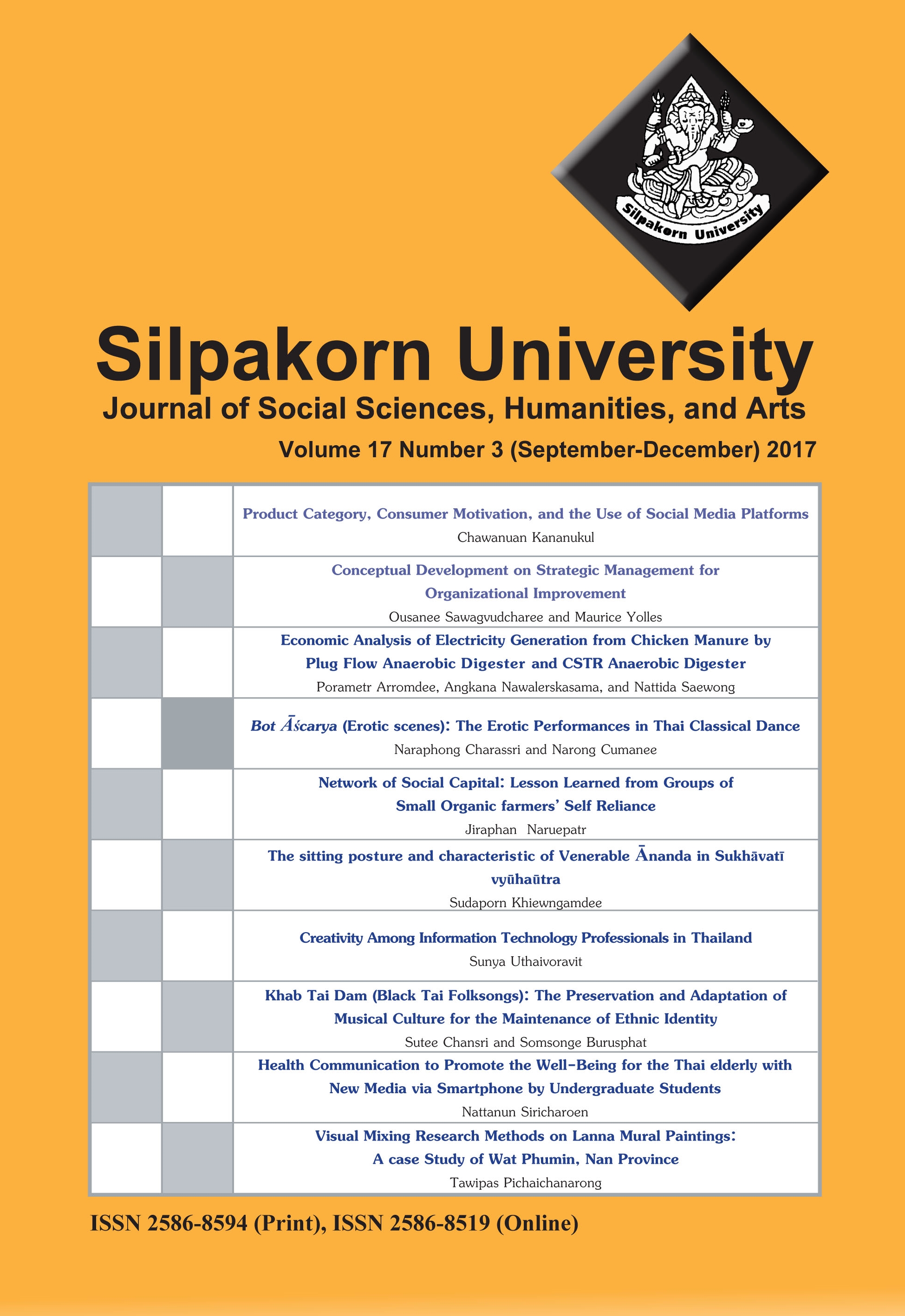Product Category, Consumer Motivation, and the Use of Social Media Platforms
Main Article Content
Abstract
This study aimed at investigating the influence of product category and consumer, on the use of social media platforms. The online surveys were administered to Thai consumers with 365 respondents. Results suggested that consumers used Twitter and YouTube for search goods more than experience goods, but used Facebook for experience goods more than search goods. In terms of consumers’ contribution to each social media platform, consumers contributed more to Facebook and YouTube than Twitter for both search and experience goods. In addition, consumers having utilitarian motivation in social media significantly contributed more to Twitter, whereas consumers having hedonic motivation in social media contributed more to Facebook. In addition to addressing some of the gaps in knowledge that exist, this study contributes to the existing literature in the areas of motivation and online consumer behavior in the context of Thailand. Practical implications of the study are discussed. Limitations and directions for future research are also provided.
บทคัดย่อ
การวิจัยเรื่องนี้เป็นการศึกษาอิทธิพลของประเภทสินค้าและแรงจูงใจของผู้บริโภคที่มีต่อการใช้สื่อสังคมออนไลน์ โดยใช้แบบสอบถามออนไลน์เป็นเครื่องมือในการเก็บข้อมูลจากกลุ่มตัวอย่างชาวไทย จำนวน 365 คน ผลการวิจัยพบว่ากลุ่มตัวอย่างใช้ Twitter และ YouTube สำหรับสินค้าที่ผู้ซื้อสามารถประเมินคุณภาพได้ก่อนซื้อมากกว่าสินค้าที่ผู้ซื้อสามารถประเมินคุณภาพได้หลังจากที่ซื้อแล้ว และใช้ Facebook สำหรับสินค้าที่ผู้ซื้อสามารถประเมินคุณภาพได้หลังการซื้อมากกว่าสินค้าที่ผู้ซื้อสามารถประเมินคุณภาพได้ก่อนการซื้อ และกลุ่มตัวอย่างมีส่วนร่วมใน Facebook และ YouTube มากกว่า Twitter ในสินค้าทั้งสองกลุ่ม นอกจากนี้กลุ่มตัวอย่างที่มีแรงจูงใจด้านอรรถประโยชน์ในการใช้สื่อสังคมออนไลน์มีส่วนร่วมใน Twitter มากที่สุด ในขณะที่กลุ่มตัวอย่างที่มีแรงจูงใจด้านความบันเทิงมีส่วนร่วมใน Facebook มากที่สุด นอกจากการเติมเต็มช่องว่างงานวิจัยแล้ว การวิจัยครั้งนี้ได้เพิ่มองค์ความรู้ที่เกี่ยวกับแรงจูงใจของผู้บริโภค และพฤติกรรมของผู้บริโภคบนสื่อออนไลน์ในบริบทของประเทศไทย รวมทั้งได้นำเสนอข้อเสนอแนะในเชิงปฏิบัติ ข้อจำกัดในการวิจัย และทิศทางสำหรับการวิจัยในอนาคต
Downloads
Article Details
All rights reserved. Apart from citations for the purposes of research, private study, or criticism and review,no part of this publication may be reproduced, stored or transmitted in any other form without prior written permission by the publisher.
References
Arnold, M. J. & Reynolds, K. E. (2003). Hedonic Shopping Motivations. Journal of Retailing 79(2), 77-95.
Babin, B. J., Darden, W. R. & Griffin, M. (1994). Work and/or Fun: Measuring Hedonic and Utilitarian Shopping Value. Journal of Consumer Research 20(4), 644-656.
Botha. E. & Mills, A. J. (2012). Managing New Media: Tools for Brand Management in Social Media. In Online Consumer Behavior, edited by A. G. Close, pp. 83-99. New York: Routledge.
Brandwatch. (2012). How Social Media is Revolutionizing the Restaurant Industry. Retrieved on July 4, 2015, from www.brandwatch.com/2012/02/socialmediaintherestaurant-industry/
Bruhn, M., Schoenmueller, V. & Schafer, D. B. (2012). Are Social Media Replacing Traditional Media in terms of Brand Equity Creation?. Management Research Review 35(9), 770-790.
Dhar, R., & Wertenbroch, K. (2000). Consumer Choice between Hedonic and Utilitarian Goods. Journal of Marketing Research 37(1), 60-71.
Douglas, S. P. & Craig, C. S. (1983) International Marketing Research. NJ: Prentice Hall.
Draft, R. L. & Lengel, R. H. (1986) Organizational Information Requirements, Media richness and Structural Design. Management Science 32(5), 554-571.
Eighmey, J. & Lola, M. (1998). Adding Value in the Information Age: Uses and Gratifications of Sites on the World Wide Web. Journal of Business Research, 41(3), 187-194.
Evans, S. (2011) Stats of the Day: 50 New Social-Media Stats to Kick-Start Your Slide Deck. Retrieved on July 4, 2015, fron https://adage.com/article/adagestat/stats-day-50-social-media-stats-kickstart-slide-deck/231093/
Green, S. B. (1991). How Many Subjects Does It Take to Do a Regression Analysis? Multivariate Behavioral Research 26(3), 499-510.
Hair, J., Black, W. C., Babin, B. J. & Anderson, R. (2010). Multivariate Data Analysis. NJ: Prentice Hall.
Harris, R. J. (1985) A Primer of Multivariate Statistics. NY: Academic Press.
Kaplan, A. M. & Haenlein, M. (2010) Users of the World, Unite! The Challenges and Opportunities of Social Media. Business Horizons 53(1), 59-68.
Kim, A. J. & Ko, E. (2011) Do Social Media Marketing Activities Enhance Customer Equity? An Empirical Study of Luxury Fashion Brand.Journal of Business Research 65(10), 1480-1486.
Klein, L. R. (1998) Evaluating the Potential of Interactive Media through a New Lens: Search versus Experience Goods. Journal of Business Research 41(3), 195-203.
Krungman, H. E. (1965) The Impact of TV Advertising: Learning without Involvement. Public Opinion Quarterly 29(3), 349-356.
Malmivaara, T. (2011) Motivations behind Liking: Implications of Facebook Brand Community Behavior on Purchase Intentions. Retrieved on July 4, 2015, from epub.lib.aalto.fi/en/ethesis/id/12719
Nelson, P. J. (1974) Advertising as Information. Journal of Political Economy 82(4), 729-754.
Parasuraman, A. & Zinkhan, G. M. (2002) Marketing to and Serving Customers through the Internet: An Overview and Research Agenda. Journal of the Academy of Marketing Science, 30(4), 286-295.
Rintamaki, T., Kanto, A., Kuusela, H. & Spence, M. T. (2006). Decomposingthe Value of Department Store Shopping into Utilitarian, Hedonicand Social Dimensions. International Journal of Retail & Distribution Management 34(1), 6-24.
Socialbakers. (2015) Free Social Media Statistics. Retrieved on January 5, 2016, from www.socialbakers.com/statistics/
Tech in Asia (2015). Thailand Social Media Stats. Retrieved on Junuary 5, 2016, from www.techinasia.com/thailand-social-media-stats
Van der Heijden, H. (2004) User Acceptance of Hedonic InformationSystems. MIS Quarterly, 28(4), 695-704.


